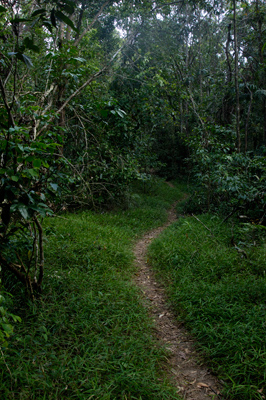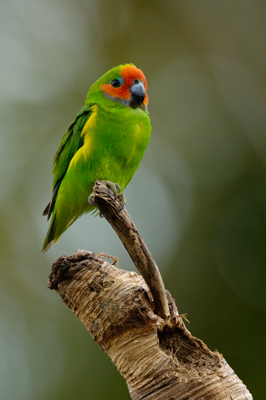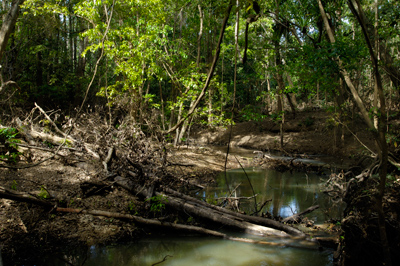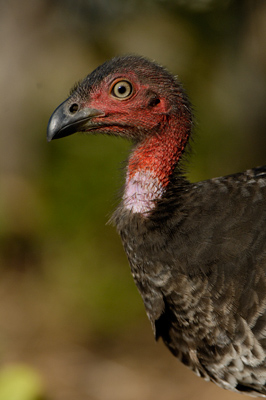The Iron Ranges are home to the largest lowland tropical rainforest in Australia. They are home to a fantastically diverse array of life, much of which is endemic to the region. Many of the birds here are more closely associated with Papua  New Guinea than with Australia, and Iron Ranges is the only place in Australia where many species can be seen. The region, like any tropical region, is dominated by two seasons, the Dry and the Wet. During the Wet, the area is inaccessible by car and all supplies and transportation must come via plane or boat through the aboriginal community of Lockhart River.
New Guinea than with Australia, and Iron Ranges is the only place in Australia where many species can be seen. The region, like any tropical region, is dominated by two seasons, the Dry and the Wet. During the Wet, the area is inaccessible by car and all supplies and transportation must come via plane or boat through the aboriginal community of Lockhart River.
When I arrived on the afternoon of September 16, 2006, the rainforest did not appear as I had envisioned. This past April, Tropical Cyclone Monica devastated the area causing massive flooding and canopy damage throughout the region. Since a growing season has not occurred since the storm, much of the rainforest hasn’t fully recovered from this disturbance. Evidence of this storm could be seen by the number of downed trees and the lack of any vegetation along the creek beds that had swollen with floods. It should be mentioned that while situations like this are often described  as destruction and devastation, it is a completely natural and, in fact, necessary natural process. Many ecosystems are intricately linked to disturbances such as fire, flood, or tropical cyclones. In a rainforest, heavy winds help to thin the canopy, providing plentiful light to the undergrowth and understory stimulating growth. Old trees are toppled, allowing for younger trees to fill the gaps in the canopy. So, while I may describe this situation as devastation, it is not with the negative connotation that the word typically carries. Though, it was a bit disappointing not to experience the immense lushness that is typical of the lowland rainforests.
as destruction and devastation, it is a completely natural and, in fact, necessary natural process. Many ecosystems are intricately linked to disturbances such as fire, flood, or tropical cyclones. In a rainforest, heavy winds help to thin the canopy, providing plentiful light to the undergrowth and understory stimulating growth. Old trees are toppled, allowing for younger trees to fill the gaps in the canopy. So, while I may describe this situation as devastation, it is not with the negative connotation that the word typically carries. Though, it was a bit disappointing not to experience the immense lushness that is typical of the lowland rainforests.
My visit to this region was partly to experience a magnificent region of forest and partly to try and track down some of the birds that only can be seen in this region or in Papua New Guinea. As far as birds go, I had quite a few target species and I saw all but three. Photography was difficult and since many of these birds were not endemic to Australia, I did not work quite as hard trying to photograph them as I have in the past. My first priority was to see and experience the region and secondly to photograph. That being said, I still managed to photograph over 15 species of birds as well as a good portion of the landscape.

Since Iron Range is located on a peninsula and is fairly isolated, many of the birds and animals are either unique to this region or the race or subspecies found there is unique. For example, the Australian Brush-Turkey, a common bird of Queensland rainforests, is quite unmistakable with its naked red head and bright yellow wattle of skin around its neck. However, on Cape York, the Australian Brush-
Turkey is of a different race and this race has a light purple wattle. Other birds like the Frill-necked Monarch are found only on the peninsula and nowhere else. Still more birds like the White-faced Robin and several species of parrot are found only here and in Papua New Guinea.

Wildlife other than birds also is plentiful. I believe nearly half the species of frogs that are found in Australia are found on the Cape York Peninsula, many of them in Iron Ranges. Many nocturnal mammals are found here, including the endemic Spotted Cuscus which I was fortunate enough to see in my campsite on my final night.
As I mentioned before, this is a very remote region with only a few permanent residents.  Two communities exist, one at Portland Roads that really only consists of one road and probably about a half dozen buildings. This remote community is situated on a gorgeous little bay and has a significant history as a base and port during World War II. The second community, Lockhart River, is primarily an aboriginal community and is a bit larger. Again, this community also has history of involvement during World War II and their current airstrip was built during that time.
Two communities exist, one at Portland Roads that really only consists of one road and probably about a half dozen buildings. This remote community is situated on a gorgeous little bay and has a significant history as a base and port during World War II. The second community, Lockhart River, is primarily an aboriginal community and is a bit larger. Again, this community also has history of involvement during World War II and their current airstrip was built during that time.
During the five nights I was camped at the small campsite at Cook’s Hut, I explored the area mostly from my campsite to Portland Roads. I was able to see many of the local specialties including Palm Cockatoo, Eclectus Parrot, Yellow-billed Kingfisher, and Green-backed Honeyeater though I was unable to photograph many them. As I mentioned I was fortunate enough to see several of Iron Range’s nocturnal residents including the Spotted Cuscus, Cape York Melomys, Northern Brown Bandicoot, Marbled Frogmouth, and I heard a Rufous Owl early one morning. It was a great five days of exploring a place that few people are able to visit and one I hope to return to some day. After all, there are still some birds that I didn’t get to see and many I didn’t get to photograph.
